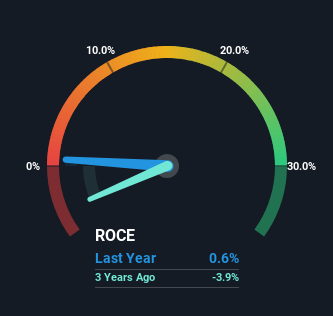- Hong Kong
- /
- Trade Distributors
- /
- SEHK:2326
These Return Metrics Don't Make New Provenance Everlasting Holdings (HKG:2326) Look Too Strong

To avoid investing in a business that's in decline, there's a few financial metrics that can provide early indications of aging. More often than not, we'll see a declining return on capital employed (ROCE) and a declining amount of capital employed. This indicates the company is producing less profit from its investments and its total assets are decreasing. So after we looked into New Provenance Everlasting Holdings (HKG:2326), the trends above didn't look too great.
What Is Return On Capital Employed (ROCE)?
For those who don't know, ROCE is a measure of a company's yearly pre-tax profit (its return), relative to the capital employed in the business. The formula for this calculation on New Provenance Everlasting Holdings is:
Return on Capital Employed = Earnings Before Interest and Tax (EBIT) ÷ (Total Assets - Current Liabilities)
0.006 = HK$2.9m ÷ (HK$1.8b - HK$1.3b) (Based on the trailing twelve months to March 2023).
So, New Provenance Everlasting Holdings has an ROCE of 0.6%. In absolute terms, that's a low return and it also under-performs the Trade Distributors industry average of 6.3%.
Check out our latest analysis for New Provenance Everlasting Holdings

While the past is not representative of the future, it can be helpful to know how a company has performed historically, which is why we have this chart above. If you're interested in investigating New Provenance Everlasting Holdings' past further, check out this free graph of past earnings, revenue and cash flow.
How Are Returns Trending?
In terms of New Provenance Everlasting Holdings' historical ROCE trend, it isn't fantastic. To be more specific, today's ROCE was 34% five years ago but has since fallen to 0.6%. What's equally concerning is that the amount of capital deployed in the business has shrunk by 27% over that same period. The combination of lower ROCE and less capital employed can indicate that a business is likely to be facing some competitive headwinds or seeing an erosion to its moat. Typically businesses that exhibit these characteristics aren't the ones that tend to multiply over the long term, because statistically speaking, they've already gone through the growth phase of their life cycle.
Another thing to note, New Provenance Everlasting Holdings has a high ratio of current liabilities to total assets of 73%. This effectively means that suppliers (or short-term creditors) are funding a large portion of the business, so just be aware that this can introduce some elements of risk. While it's not necessarily a bad thing, it can be beneficial if this ratio is lower.
Our Take On New Provenance Everlasting Holdings' ROCE
To see New Provenance Everlasting Holdings reducing the capital employed in the business in tandem with diminishing returns, is concerning. This could explain why the stock has sunk a total of 76% in the last five years. With underlying trends that aren't great in these areas, we'd consider looking elsewhere.
New Provenance Everlasting Holdings does have some risks, we noticed 3 warning signs (and 1 which is a bit unpleasant) we think you should know about.
While New Provenance Everlasting Holdings isn't earning the highest return, check out this free list of companies that are earning high returns on equity with solid balance sheets.
Valuation is complex, but we're here to simplify it.
Discover if New Provenance Everlasting Holdings might be undervalued or overvalued with our detailed analysis, featuring fair value estimates, potential risks, dividends, insider trades, and its financial condition.
Access Free AnalysisHave feedback on this article? Concerned about the content? Get in touch with us directly. Alternatively, email editorial-team (at) simplywallst.com.
This article by Simply Wall St is general in nature. We provide commentary based on historical data and analyst forecasts only using an unbiased methodology and our articles are not intended to be financial advice. It does not constitute a recommendation to buy or sell any stock, and does not take account of your objectives, or your financial situation. We aim to bring you long-term focused analysis driven by fundamental data. Note that our analysis may not factor in the latest price-sensitive company announcements or qualitative material. Simply Wall St has no position in any stocks mentioned.
About SEHK:2326
New Provenance Everlasting Holdings
An investment holding company, sources and sells metal minerals and related industrial materials in Hong Kong and the People’s Republic of China.
Flawless balance sheet low.
Market Insights
Community Narratives




